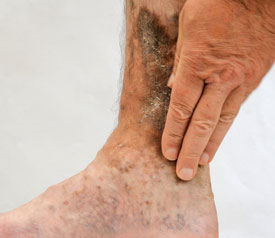
Ischemic ulcers and wounds are a major problem for some patients. Aside from causing pain, they can lead to permanent skin and tissue damage. Taking good care of these wounds is important for a full recovery. Proper wound dressing, cleaning, and best practices can help patients eliminate ischemic ulcers and help prevent future ones.
What is an ischemic ulcer?
Ischemic wounds and ulcers are serious health issues that involve poor blood flow, primarily to the extremities. When arterial blood supply is slowed or blocked, an ulcer can easily form and lead to serious health issues.
Limited blood flow to any area of the body causes cells in that area to die and quickly causes tissue damage. Depending on the severity of the ulcer, the wound can be very slow to heal, if it ever heals fully at all. Many ischemic ulcers and wounds take weeks or months to fully repair.
These types of ulcers are most common on the extremities, such as the legs, arms, hands, and feet. Arterial blood flow takes longer to reach these areas than any other part of the body.
Treatment of ischemic ulcers and wounds must be performed carefully as to not further damage the skin. Applying soft wound dressings and securing them with Hy-Tape can assist in the healing process. Hy-Tape is designed to securely hold wound dressings without adding extra stress to the skin. It can also be used for securing cannulas and medical devices.
Causes of ischemic ulcers and wounds
Ulcers of every kind are serious health issues, and it’s important to understand what helps cause these ailments. Ischemic ulcers and wounds are commonly caused by one of two problems:
Clogged arteries – Atherosclerosis, or clogging of the arteries, is the most common source of ischemic ulcers. Limited blood flow from the arteries results in damaged tissues and dying cells, leading to painful wounds that need treatment.
Inflammatory conditions – Any health issues that cause inflammation can also raise the chances of an ischemic ulcer or wound. Inflammation can help build up fluid in the extremities, leading to the development of a wound.
No matter the cause, ischemic ulcers need immediate care from medical professionals.
Identifying ischemic ulcers
Knowing that an ischemic ulcer is forming is vital to beginning treatment and repairing the damage. A few signs of these wounds include:
- Wounds appearing on hands, fingers, feet, or toes
- Lack of bleeding when cut open
- Pale, cool extremities
- Pain and soreness in the extremities
- Skin appearance changing to shiny, dry, or hairless
Any of these issues can be signs of poor blood flow to the extremities. Over time, these problems will only get worse and could lead to serious wounds and permanent tissue damage.
Patients who have any of these symptoms should visit a doctor for a detailed examination. A wound specialist can use laboratory tests, MRI, CT scans, and other studies to diagnose an ischemic ulcer and begin treatment.
Risk factors for ischemic ulcers and wounds
Not everyone is at high risk for ischemic ulcers, but it’s important to know the risk factors that could cause problems. A few health issues that can lead to these ulcers include:
- Inflammatory diseases such as Lupus
- High cholesterol levels
- High blood pressure
- Blockage of lymph vessels
- Chronic kidney disease
- Lifestyle choices such as smoking
While these risk factors raise the chances of an ulcer, they are not a requirement. Patients who suspect they are developing an ulcer should consult a doctor immediately.
Caring for ischemic ulcers
Taking proper care of ischemic ulcers and wounds can lead to complete recovery for the patient. It’s important to begin caring for these wounds as soon as they are diagnosed.
Cleaning a wound thoroughly is important before adding a dressing. A wound that is not fully cleaned can easily get infected and stay infected if a dressing is applied. With careful cleaning, there is a much better chance of skin repair.
Keeping an ischemic wound bandaged and clean is essential. Securing a wound dressing with Hy-Tape ensures that no liquid or bacteria gains access to the wound. Hy-Tape holds well to the skin and does not irritate with movement. It also removes easily, helping to ensure that no additional skin damage is experienced.
Preventing ischemic ulcers and wounds
Prevention of ischemic ulcers is possible, especially if warning signs are caught early. Patients who have a history of inflammatory health issues should be vigilant against these wounds. Those with high cholesterol or high blood pressure should also consider checking for these ulcers regularly.
Sitting still for long periods of time can aid in the development of ulcers and wounds. Sitting for extended periods can slow blood flow to the extremities.
Protecting the extremities from cold temperature is essential to avoiding wound development. Cold temperatures help slow blood flow in the fingers and toes.
Just as extreme cold is a problem, so is extreme heat. Soaking hands or feet in hot water can cause issues with blood flow and result in ulcers or wounds.
Avoiding compression socks and gloves is also important for avoiding ulcers. These products restrict blood flow and can lead to sores and wounds for high-risk patients.
Taking good care of ischemic wounds and sores is vital for the repair of the skin and tissues. When these wounds need dressing, Hy-Tape is the best way to secure them. Hy-Tape is designed to be sensitive to the nearby skin, staying in place without tugging or scratching.
Contact us today to learn more about how Hy-Tape can help in the healing of ischemic wounds and sores.

